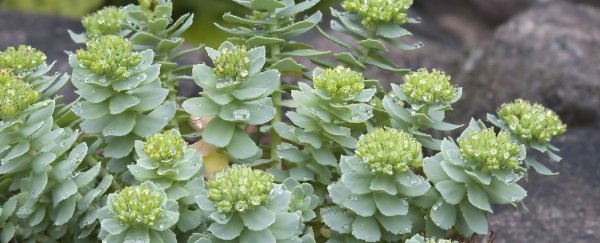A collective of Alaskan farmers have begun growing a stubby Siberian plant with a secret history of medicinal powers, and they hope it could become one of the state's most valuable crops.
The Rhodiola Rosea plant, also known as golden root, is native to Siberia, and grows throughout the Altai mountain ranges, which serve as a boundary between China, Mongolia, Russia and Kazakhstan. It's a hardy plant suited to cold temperatures, and grows in permafrost, which is a layer of soil beneath the surface where temperatures have been continuously below freezing for several years.
So far, the plant seems right at home in Alaska: "It's actually an environment that the plant wants to grow in, as opposed to everything else we grow," agricultural scientist Stephen Brown from the University of Alaska-Fairbanks in the US, told Sarah Laskow from Atlas Obscura.
"It'll grow in the Arctic and sub-Arctic. It wants our long days. It's already coming up out of the ground - and the ground's still frozen."
The appeal of golden root for Alaskan farmers is the potential to make substantially higher profits per acre than by selling other staple crops grown in the region, such as potatoes, reports Laskow. This is largely due to a plethora of perceived health benefits to be gained from the plant's extracts.
Golden root has been used for centuries in traditional medicines and teas in Siberia and China, where people have long claimed that the plant had the potential to treat seasonal depression, improve strength and endurance, protect against altitude sickness, and act as an aphrodisiac - particularly for women.
As early as the 1940s, and throughout the Cold War, the plant became the subject of Soviet military investigations - though the extent of this research, and what was discovered remains somewhat foggy.
Petra Illig, a pilot and medical doctor who founded the cooperative of golden root farmers in Alaska - called Alaska Rhodiola Products - told Laskow the plant "was considered a Soviet military secret."
"Most of what was done back then was unpublished and hidden in drawers in Moscow. They used it for the physical and mental performance of their soldiers and athletes," she said, adding that she's also confirmed it was tested on cosmonauts.
Western medicine only began to seriously investigate the plant in 2007 after a clinical trial in Armenia showed that 500 milligrams of golden root extract had the potential to help treat mild to moderate depression.
In 2013, researchers at the University of California-Irvine showed that it might also hold some promise for keeping us young.
They found when fruit flies were fed extracts of the root they lived 24 percent longer than their otherwise healthy peers - an average of about three days longer. They also found that it could extend the lifespan of yeast and worms, and published their results in the journal PLOS One.
"Potentially, humans - healthy or not - could live longer by consuming this root," lead author and pharmacologist Mahtab Jafari said in a press release at the time. "So far, we've only seen the effect in flies, worms and yeast. But nothing quite like this has been observed before."
Although the plant has not been approved by the US Food and Drug Administration (FDA) as a treatment for any ailments, Laskow from Atlas Obscura says, "sales are growing in American health food markets, and even faster in US mainstream markets, where it's been newly introduced."
The farmers working on cultivating the plant currently have about 5 acres and are trying to expand this. "At 200 acres, it would be the most valuable crop in the state," Brown said.
